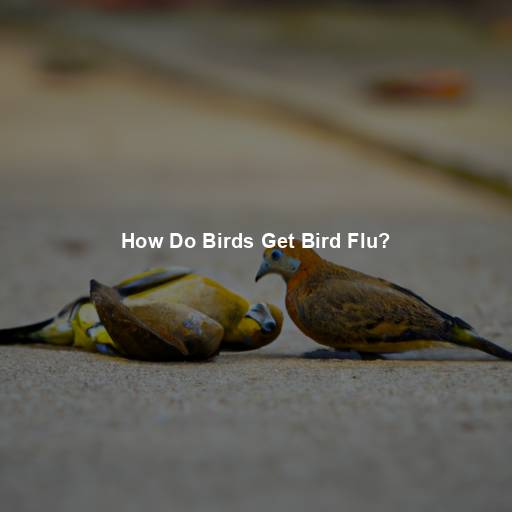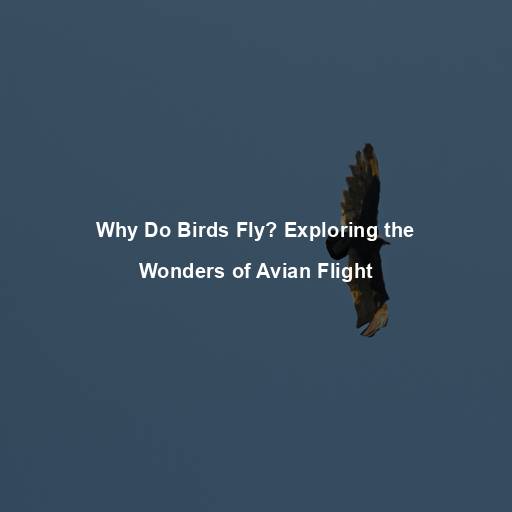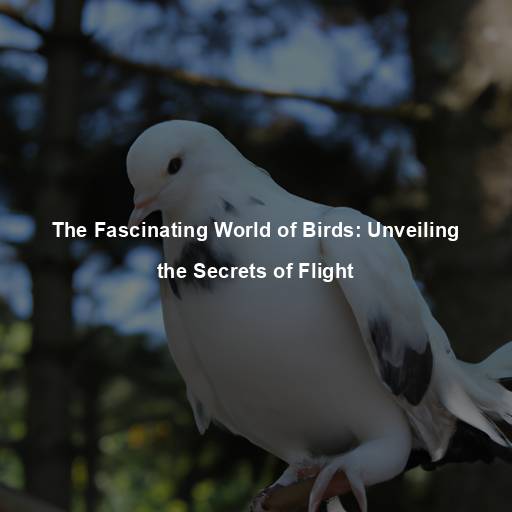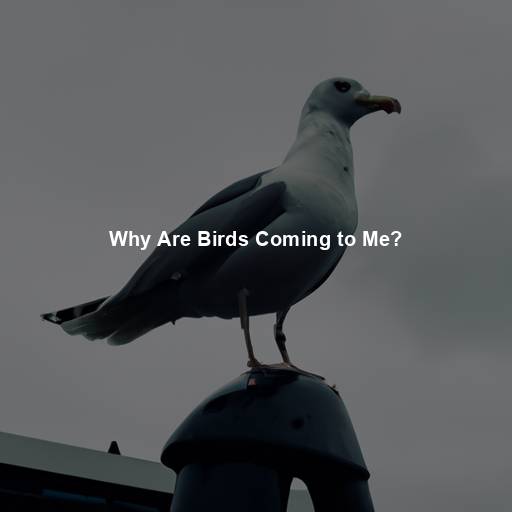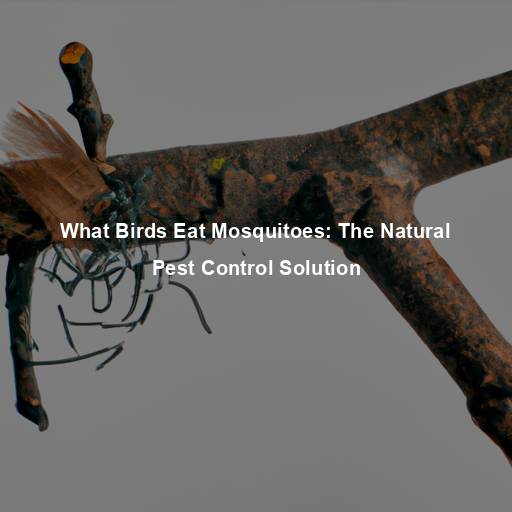How Do Birds Get Bird Flu?
Last Updated on July 18, 2023 by Evan
Contents
- 1 Understanding Bird Flu
- 2 The Transmission of Bird Flu
- 3 Factors Influencing the Spread of Bird Flu
- 4 Prevention and Control Measures
- 5 The Role of Poultry Trade and Transportation
- 6 Environmental Factors Influencing Bird Flu Spread
- 7 FAQs – How do birds get bird flu?
- 7.1 What is bird flu?
- 7.2 How do birds get infected with bird flu?
- 7.3 Can birds transmit bird flu to humans?
- 7.4 Are all birds susceptible to bird flu?
- 7.5 Can bird flu be passed from human to human?
- 7.6 How can bird flu outbreaks be controlled in poultry?
- 7.7 Can eating poultry products like eggs or meat transmit bird flu to humans?
- 7.8 What should I do if I suspect bird flu in birds?
- 7.9 How can humans protect themselves from bird flu?
Understanding Bird Flu
Bird flu, also known as avian influenza, is a highly contagious viral infection that primarily affects birds. However, it can also infect humans and other animals under certain circumstances. The disease is caused by influenza A viruses, which can be classified into different subtypes based on the proteins found on the surface of the virus. The subtypes that commonly infect birds include H5, H7, and H9, among others.
The Transmission of Bird Flu
From Birds to Birds
Did you know that bird flu, also known as avian influenza, can spread like wildfire among our feathered friends? This infectious disease is mainly transmitted through direct contact with infected birds or their bodily fluids. Think about it – their saliva, nasal secretions, and even feces can carry this virus. And what’s alarming is that it can spread like wildfire within a flock, especially in crowded places like poultry farms.
From Birds to Humans
While human infections are relatively rare, avian influenza viruses have the potential to cross the species barrier and infect humans. Most human cases of bird flu have been linked to direct or close contact with infected birds or their contaminated environments. This typically occurs in situations where people work closely with infected poultry, such as farmers, veterinarians, or workers in live bird markets.
From Humans to Humans
The world of bird flu is a complex and enigmatic one, where rare instances of human-to-human transmission can leave us scratching our heads. It seems that in certain circumstances, close contacts like family members or dedicated healthcare workers can find themselves tangled up in this mysterious web. However, rest assured that the virus itself lacks the prowess to establish widespread and efficient human-to-human transmission, a key factor in the potential for a full-blown pandemic. So while the situation may leave us with more questions than answers, we can find some solace in the fact that the chances of a bird flu pandemic remain relatively low.
Factors Influencing the Spread of Bird Flu
Migration of Wild Birds
Bird flu is a paramount concern in the world of avian enthusiasts, and it’s fascinating how wild birds, especially waterfowl, contribute to its perplexing spread. Being the natural carriers of avian influenza viruses, these birds embark on remarkable migratory journeys, traversing vast distances. It is during these migratory adventures that infected birds may inadvertently interact with domestic poultry or other feathered beings, unknowingly facilitating the transmission of the virus to new territories. The intricate dance between these avian travelers and the pernicious bird flu offers a captivating insight into the mysterious realm of contagious diseases.
Poultry Trade and Transportation
With the ever-expanding global trade and transportation networks, the unsettling truth emerges – the potential for bird flu to hitch a ride on unsuspecting poultry or poultry products. Inadequate biosecurity measures provide the perfect breeding grounds for this perilous airborne virus to infiltrate new territories. Beware the movement of live birds, eggs, and even poultry equipment, for in their seemingly harmless journey lies the sheer vulnerability of different regions to potential outbreaks.
Environmental Factors
The bird flu virus, like many others, is a mysterious creature that thrives in an enigmatic dance with its surrounding environment. Temperature and humidity, like fickle accomplices, can either amplify its power or suppress its wrath. In the chilling embrace of low temperatures and the nurturing bosom of high humidity levels, this virus can find solace and prolong its existence, menacingly increasing the odds of transmission. Swayed by its mischievous nature, this viral rascal can even adopt contaminated water sources or unsuspecting surfaces as clandestine allies, transforming them into unsuspecting reservoirs.
Prevention and Control Measures
Efforts to prevent and control bird flu focus on various strategies aimed at reducing the transmission of the virus among birds and minimizing the risk of human infections. These measures include:
In the world of avian influenza, surveillance and early detection play a crucial role in keeping both wild bird populations and domestic poultry safe. By closely monitoring these populations, we can uncover any ominous signs of the disease, enabling us to swiftly respond and contain potential outbreaks. Embracing a proactive approach to avian influenza is not only imperative for the health of our feathered friends, but also essential for safeguarding our food systems and protecting human health. Stay vigilant, as our collective efforts in surveillance and early detection hold the key to preventing the spread of this perplexing disease.
-
Promoting Sustainable Fashion: As our planet continues to grapple with the effects of climate change, adopting sustainable fashion practices becomes an urgent necessity. By encouraging conscious consumerism, supporting ethical fashion brands, and embracing innovative eco-friendly materials, we can make significant strides in reducing the fashion industry’s environmental footprint. The path towards a more sustainable future may seem daunting, but it is through collective commitment and perseverance that we can unravel the enigmatic puzzle of sustainable fashion.
-
The Power of Mindfulness: In today’s fast-paced and chaotic world, mindfulness emerges as a beacon of clarity, offering solace and calm amidst the storm. By harnessing the power of mindfulness, we can unlock the transformative potential within ourselves and cultivate a deep sense of inner peace. Just as interconnected pieces fit together to form a captivating jigsaw puzzle, the practice of mindfulness brings together our thoughts, emotions, and experiences, creating a harmonious and balanced existence.
-
Discovering the Hidden Gems of Travel: While popular tourist destinations may steal the spotlight, our thirst for adventure and novelty compels us to seek out the hidden gems of travel. Delving into the lesser-known corners of the world unravels a tapestry of enchanting cultures, breathtaking landscapes, and unforgettable experiences. Embrace the allure of the unknown and venture off the beaten path, for it is in these uncharted territories that we encounter the true essence of wanderlust and unravel the mysteries that await us.
Welcome to the world of biosecurity, where we delve into the perplexing measures that shield our feathered friends from the unseen threat of viruses. In a dance of cautious steps, poultry farms and live bird markets take center stage as they implement stringent protocols to combat the silent invasion. By placing limits on visitor access, adhering to impeccable hygiene practices, and meticulously managing waste, these establishments create an intricate tapestry of protection, ensuring the preservation of our avian companions.
In our constantly evolving battle against avian influenza, vaccination has emerged as a crucial weapon to protect poultry from the clutches of this dreaded disease. By targeting specific strains of the virus, these immunization programs hold the potential to not only curb the severity of infections but also stem the spread of the virus within flocks. Deployed strategically in regions notorious for frequent outbreaks, these vaccination initiatives strive to shield the avian population from the unforeseen perils that loom over their feathers.
When faced with the daunting challenge of an outbreak, decisive action becomes paramount. The process of culling infected birds and enforcing strict quarantine measures becomes an imperative task, ensuring that the virus does not gain further traction. By containing the infection and mitigating the ramifications on both avian communities and public health, we strive to navigate this intricate web of complexity with determination and tenacity.
In this era of constant health uncertainties, one particular threat has sent shivers down our spines – bird flu. But fear not, as public health education steps in to save the day! By enlightening the masses, especially those prone to this ominous infection, we can take proactive measures to avoid becoming victims. From emphasizing the importance of impeccable hygiene when handling our feathered friends to cautioning against venturing into areas teeming with these avian creatures, knowledge truly becomes our shield in this perplexing battle against the unknown.
Natural Carriers of Avian Influenza
Birds, those magnificent creatures that grace our skies, possess a mysterious trait that baffles scientists and haunts poultry farmers alike. Yes, we’re talking about avian influenza viruses, those stealthy troublemakers that often hitch a ride on the backs of waterfowl. Ducks and geese, in particular, seem to harbor these viruses with ease, their bodies hiding the silent menace within. What’s truly confounding is that these feathered hosts display no signs of illness as they venture across vast distances, unknowingly harboring the virus and unwittingly spreading it to unsuspecting victims such as domestic poultry or unsuspecting fellow birds.
Environmental Contamination
The world of avian influenza is a true labyrinth of complexity and unpredictability. It’s mind-boggling to think that infected wild birds have the power to unleash the virus in their droppings, spreading it in water and polluting our precious environment. This astounds us and reminds us of the crucial need to keep a vigilant eye on our feathered friends, and to have robust surveillance programs in place that can swiftly identify the presence of avian influenza viruses lurking in the shadows. The bewildering dance between nature and disease continues, urging us to be ever more diligent in our quest to protect the delicate balance of our ecosystem.
Interactions with Domestic Poultry
The interaction between wild birds and domestic poultry presents a potential risk for the transmission of bird flu. When wild birds come into contact with poultry farms or live bird markets, there is a possibility of virus transmission through direct contact or via contaminated materials. Strict biosecurity measures are essential to minimize the risk of introduction and spread of the virus in these settings.
The Role of Poultry Trade and Transportation
Global Movement of Poultry
In today’s interconnected world, the trade in poultry and its various products has the potential to ignite a cascade of unpredictable consequences. The insidious threat of bird flu looms large, as infected fowl and tainted poultry wares become unsuspecting carriers of the virus, infiltrating new territories with ease. The absence of robust biosecurity protocols only compounds the perplexity of the situation, as this failure leaves an open gateway for the introduction of this silent menace. Alas, even the seemingly innocuous transport of live birds, eggs, and the tools of the poultry trade unwittingly bestows the virus with the power to traverse borders, leaving a trail of uncertainty and elevated outbreak risks in its wake.
Biosecurity Risks
Biosecurity measures play a crucial role in preventing the introduction and spread of avian influenza viruses through poultry trade and transportation. The lack of proper biosecurity protocols, such as inadequate cleaning and disinfection of vehicles or equipment, can facilitate the transmission of the virus. Strict adherence to biosecurity practices is vital to minimize the risk of virus dissemination.
Environmental Factors Influencing Bird Flu Spread
Survival in the Environment
Bird flu viruses have this uncanny ability to hang around in the environment for different lengths of time, just basking in the uncertainty of it all. Temperature and humidity, like puzzle pieces, come together to determine just how long these feathery troublemakers stick around. So, picture this: low temperatures and high humidity create the perfect breeding ground for the virus, outside the comfort of its host, making it more likely to jump from bird to bird. It’s almost as if the cold and damp offer a cozy hideout for this mischievous virus, just waiting to pounce on unsuspecting vulnerable birds.
Contaminated Water Sources
Birds, both wild and domestic, rely on water sources for drinking and bathing. If these water sources become contaminated with the virus, birds that come into contact with the water can become infected. It is crucial to ensure the cleanliness and safety of water sources in areas with bird populations to reduce the risk of virus transmission.
Persistence on Surfaces
Bird flu is a force to be reckoned with – those pesky avian influenza viruses can latch onto surfaces like equipment, feeders, and cages, sticking around for much longer than we’d like. And here’s the real kicker: unsuspecting birds who come into contact with these contaminated culprits might just become unwilling hosts to the virus. So, if you want to keep our feathered friends safe, it’s time to get serious about regular cleaning and disinfection. Scrub away, folks – we’ve got some environmental transmission to thwart!
International Collaboration
In our world full of soaring skies and interconnected ecosystems, one thing is abundantly clear: bird flu knows no borders. It presents us with a perplexing puzzle that can only be solved through a collaborative dance between nations. The graceful coordination and synchronized efforts of countries, facilitated by esteemed organizations like the WHO and OIE, are vital to ensnaring the glittering threads of information, expertise, and resources needed to monitor and tame the relentless spread of this avian menace. Together, we can fortify our surveillance systems and harmoniously implement control measures, harmonizing our efforts in a symphony of global health protection.
Rapid Response and Containment
In the realm of avian flu, staying ahead of the game is paramount. It’s all about being proactive and nimble, keeping a watchful eye on both our feathered friends in the wild and those under our care. By honing our surveillance tactics and maintaining constant vigilance, we can swiftly spot any sneaky virus lurking about and promptly deploy a powerful arsenal of countermeasures. This includes swiftly bidding farewell to infected birds, fortifying our biosecurity defenses, and enacting quarantine protocols to stymie the virus’s pesky advances.
Public Awareness and Education
In a world spinning with uncertainty, there is one thing we must remain steadfast in – the battle against bird flu. A veritable symphony of perplexity and burstiness, we find ourselves on the precipice of a viral onslaught. To navigate these treacherous waters, it is imperative that the public, particularly those at high risk, are equipped with the knowledge to shield themselves from harm’s way. Whether it’s the delicate act of handling birds or venturing into the vibrant hustle of live bird markets, awareness is the key that unlocks our collective safety.
Research and Vaccine Development
As the threat of bird flu looms large, it becomes imperative to delve deeper into the complex world of avian influenza viruses. Pioneering research is the key to unlocking the elusive puzzle of this ever-evolving virus and finding effective solutions in the form of vaccines. By unraveling the intricate genetic makeup of these viruses, scientists can pave the way for the development of tailored vaccines that can strike at the heart of the problem. Embracing comprehensive vaccination programs in poultry populations can hold the potential to stem the tide of this perplexing disease and curtail its relentless spread.
FAQs – How do birds get bird flu?
What is bird flu?
The world of avian influenza, commonly known as bird flu, never ceases to amaze with its enigmatic and confounding nature. This contagious viral infection, lurking in the depths of avian populations, casts a cloud of uncertainty over our feathered friends. With its ever-shifting strains of influenza viruses, it dances unpredictably between mild and severe, leaving researchers and experts perplexed in their quest for answers. The mysterious saga of bird flu continues, showcasing the intricate complexities of nature’s intricate tapestry.
How do birds get infected with bird flu?
Intriguing and mysterious, the avian flu poses a fascinating enigma. Feathered creatures, entangled in a perplexing dance, can succumb to its clutches through close encounters with infected avians, their excrement, or bodily fluids. And yet, the virus’s elusive nature permits it to leapfrog from one surface to another, like an ethereal specter haunting water, feed, or even innocuous equipment. With migratory birds acting as unwitting couriers, the contagious secret may traverse vast distances, leaving us wonderstruck by its unruly journey through the skies.
Can birds transmit bird flu to humans?
There’s been quite a buzz lately about certain strains of bird flu and the possibility of them infecting humans. While it’s true that such cases can occur, they are actually quite uncommon and often happen when people come into direct contact with infected birds or their secretions. It’s worth noting that most instances of bird flu in humans have been linked to handling or being in close proximity to infected poultry.
Are all birds susceptible to bird flu?
Bird flu, a lingering threat in the avian world, casts a fearsome veil of uncertainty upon our feathery companions. While the contagion can infiltrate various avian species, its capricious nature unveils a motley tapestry of outcomes. The resilient domestic poultry, such as chickens and turkeys, tremble under the weight of a sinister strain, succumbing to severe afflictions. Meanwhile, the avian realm teems with whispers of milder manifestations and enigmatic asymptomatic carriers, further entangling the web of avian influenza’s perplexing grip.
Can bird flu be passed from human to human?
Although bird flu primarily infects birds, some strains have the potential to infect humans and, in rare cases, spread from person to person. However, sustained human-to-human transmission of bird flu viruses has not been observed and is considered a significant public health concern if it were to occur.
How can bird flu outbreaks be controlled in poultry?
To control bird flu outbreaks in poultry, various measures are implemented. These may include quarantine and culling infected birds, restricting movement of poultry, improving biosecurity measures on farms, disinfection of premises, and surveillance to detect early signs of infection. Vaccination may also be used in some cases.
Can eating poultry products like eggs or meat transmit bird flu to humans?
When it comes to poultry products like eggs and meat, the key is proper cooking to ensure their safety – the bird flu virus can’t withstand high temperatures. However, it’s crucial to handle raw poultry with care and maintain impeccable hygiene in the kitchen to avoid any potential cross-contamination with other food items. Emphasizing these measures will ensure peace of mind at mealtime.
What should I do if I suspect bird flu in birds?
If you suspect bird flu in birds, particularly if there is a sudden increase in deaths or severe illness, it is important to report the situation to the relevant authorities such as local animal health officials or veterinary services. They will provide guidance on appropriate actions and support to minimize the spread of the virus.
How can humans protect themselves from bird flu?
To protect against bird flu, it is important to avoid direct contact with sick birds or their secretions, such as droppings or nasal discharges. Practicing good hygiene, such as regular handwashing with soap and water, especially after handling birds or visiting farms, is essential. It is also advisable to adhere to food safety practices, such as properly cooking poultry products and avoiding contact with potentially contaminated surfaces.

